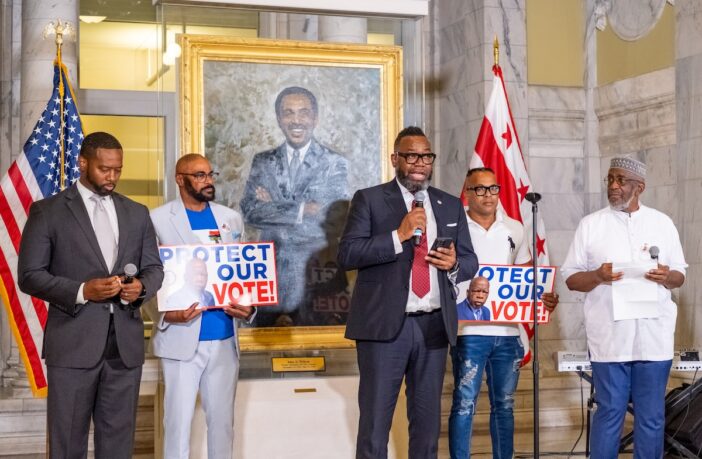Four years after Congressman John Lewis’ death, organizers continue to advance a cause near and dear to his heart — protection of voting rights.
A bevy of local and national organizations converged on the first floor of the John A. Wilson Building in Northwest D.C. on July 17 for what they dubbed the John Lewis National Day of Action. That evening, D.C. Mayor Muriel Bowser (D), one of the last people to spend time with the late Lewis, emphasized the significance of the commemoration.
“We will cast our ballots [in November]for how we save our democracy and our right to vote,” Bowser said, alluding to the threat of another Donald J. Trump presidency. “We want to ensure our already limited autonomy is not trampled on.”
In 2020, Bowser hosted Lewis during his last public appearance at the two-block pedestrian walkway on 16th Street she officially renamed Black Lives Matter Plaza. Weeks later, in his last letter, Lewis reflected on George Floyd’s police-involved murder, likening the nationwide response to what he witnessed in the aftermath of Emmitt Till’s death.
Lewis also touted voting as a nonviolent act of resistance and means of making “good trouble.” On Wednesday, Bowser reflected on those words and emphasized the necessity of preserving Lewis’ legacy.
“We have to be careful that we don’t lose the history,” Bowser said. “We have to make sure our activists and educators are reminding everyone about the remarkable life of John Lewis.”
Preserving the Vote, and Encouraging Others to Participate
The November general election stands to not only determine this country’s future, but the populace’s appetite for the ballot box.
Locally, voter turnout during the June 4 primary stood at less than 26%, despite the option of mail-in ballots and early voting. During the 2022 D.C. Democratic primary that Bowser won, fewer than 35% of registered Democrats cast their ballots. Months later, Bowser secured a general election victory with fewer than 41% of voters showing up to the polls.
It’s estimated that, nationwide, more than 100 million people choose not to vote, though they are eligible to do so.
As organizers attempt to engage that populace, coordinators of the John Lewis National Day of Action continue to tout the John R. Lewis Voting Rights Advancement Act, the Freedom to Vote Act, and the Native American Voting Rights Act as tools in protecting and expanding access to the ballot box.
The Native American Voting RIghts Act, if passed, includes provisions that allow tribal ID cards to be used for voting purposes. The John R. Lewis Voting RIghts Advancement Act would restore and strengthen portions of the Voting Rights Act of 1965. Since 2021, it failed to pass the Senate twice, including as part of a combined bill with the Freedom to Vote Act.
For some people, like Barbara Arnwine, time’s of the essence in making the push for these bills.
“John Lewis was a champion of voting rights and a dear friend of mine. We know his legacy and we’re going to finish the job,” said Arnwine, president and founder of the Transformative Justice Coalition, as she acknowledged similar commemorative events in more than 80 cities. “Hundreds of people are listening and watching this event. They are committed. We get calls from all over the country, from sea to shining sea. People are saying ‘We love you, John Lewis.’”
A Memorable, and Meaningful, Event
Organizations such as People For the American Way, Secure Our Vote, League of Women Voters, and the D.C. chapter of Black Voters Matter were all at the John A. Wilson Building on Wednesday to continue Lewis’ legacy.
EZ Street of WHUR 96.3 FM and Daryl Jones of the Transformative Justice Coalition served as masters of ceremony while Lemonade Dream, a Duke Ellington School of the Arts (DESA) student, read Lewis’ last letter.
DESA choir members would later perform a musical number in honor of Lewis.
Other speakers included Alma Couverthie, chief of programs and interim co-CEO of the League of Women Voters, Svante Myrick, president and CEO of People For the American Way, and Jalisa Giles, campaign coordinator for Public Citizen’s Secure Our Vote Coalition.
Tara Murray, executive director of the National Urban League’s Washington bureau and senior vice president for policy and advocacy, also took to the podium. In recognition of barriers to voting that exist in several states, she evoked Lewis’ legacy, and that of Whitney Young, the pioneering National Urban League executive director.
“John Lewis and Whitney Young knew that racial justice required the full participation of citizens in the democratic process,” Murray said. “We face a pivotal moment [with]a coordinated effort to roll back protections John Lewis fought for… We must safeguard the rights he worked so hard to secure.”
At the age of 23, Lewis counted among the six leaders who organized the 1963 March on Washington for Jobs and Freedom. He was also the youngest speaker at the event. In 1965, Lewis led the first of three marches between Selma and Montgomgery, Alabama, across the Edmund Pettus Bridge, where state troopers and police attacked him and other marchers.
The all-out assault that came to be known as “Bloody Sunday” led to the passage of the Voting Rights Act. Decades later, Georgia voters elected Lewis to the House of Representatives, where he would serve 17 terms.
On Wednesday, the John Lewis Day of Action event closed with a candlelight vigil during which The Rev. Thomas Bowen, senior adviser in the White House Office of Public Engagement, led the growing crowd in prayer. But not before giving a reflection that ended in a call to action.
“He taught us that ‘good trouble’ is a phrase [and]call to action to speak out and fight for what’s right even when it’s difficult,” Bowen said. “He showed us the path to justice is lined with obstacles. As we light our candles, let the flames represent our commitment to carry out John Lewis’ legacy. We stand against injustice and bring a voice for the voiceless.”



